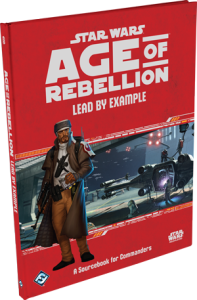
Chris’ Quick Take: Lead by Example is a must buy for Age of Rebellion Gamemasters, but is pretty light on equipment and the appeal of the specializations will depend on your style of game. Players may want to have a look through at their FLGS or check out the specialization trees at a place like Begging for XP before purchasing.
 Fantasy Flight Games’ Lead by Example: A Sourcebook for Commanders is the latest career sourcebook for Age of Rebellion. By now, we’ve learned what we get from these sourcebooks and my expectation for this $40 Canadian (US MSRP $29.95) book is pretty high, especially after the extremely player-friendly Desperate Allies sourcebook for Diplomats. Ultimately this book gets a mixed recommendation. I’m not convinced this is the book for all Commander PCs because it is a bit light on player options. However, Lead by Example is highly recommended for GMs. The expanded Mass Combat Rules alone have justified my purchase. As with my Force and Destiny review, I’ll comment and critique as we make our way through the book.
Fantasy Flight Games’ Lead by Example: A Sourcebook for Commanders is the latest career sourcebook for Age of Rebellion. By now, we’ve learned what we get from these sourcebooks and my expectation for this $40 Canadian (US MSRP $29.95) book is pretty high, especially after the extremely player-friendly Desperate Allies sourcebook for Diplomats. Ultimately this book gets a mixed recommendation. I’m not convinced this is the book for all Commander PCs because it is a bit light on player options. However, Lead by Example is highly recommended for GMs. The expanded Mass Combat Rules alone have justified my purchase. As with my Force and Destiny review, I’ll comment and critique as we make our way through the book.
Chapter One, as always, begins with an often-overlooked section on player backgrounds starting on page 13. There’s some good stuff here, especially the section on citizen soldiers, so take Keith Ryan Kappel’s advice and give this section a second look. The new Duties, on page 17, include some very nice options including Camaraderie, Enemy Demoralization, and a well thought out take on the existing Support duty.
Three species are included in the book: the Chagrians, Ishi Tib, and Lannik. All three would make a good Commander. Chagrians can leverage their good Willpower, and their free Knowledge Specialization talent can synergize nicely with the new Strategist specialization. The Ishi Tib and the Lannik both boast a good Intellect, with the Ishi Tib getting a rank of Discipline to mitigate low Willpower, and the Lannik taking a hit to potentially unimportant Agility.
The new specializations include Figurehead, Instructor, and Strategist. The Figurehead and Strategist integrate well with Mass Combat rules. The Figurehead has a talent that allows the use of Cool instead of Leadership in Mass Combat, which can be combined with ranks of Commanding Presence to make a great commander, while keeping flexible enough to be useful in more conventional Face roles. Improved Commanding Presence, a talent allowing a Figurehead to force a target to leave an encounter using a Cool vs Discipline check, gets special mention due to awesome. The Strategist has a very heavy focus on Mass Combat with some very effective talents that directly impact that mechanic. However, while some of those talents can be used on the personal scale, this focus on Mass Combat can make the Strategist an inefficient choice should Mass Combat be a rare occurrence in your campaign. So if Mass Combat is not going to be a big part of your game, then the Analyst may be a better pick for the same thinking commander concept. The Instructor does not interact with the Mass Combat mechanics, instead offering a very well rounded leader including the Medicine skill, Stimpack Specialization, Bodyguard, and Physical Training on top of thematic leadership talents. Figurehead and Instructor have some good utility, but may not be exactly what you are looking for. Strategist will be great for Mass Combat, but potentially wastes a lot of talents if that mechanic won’t be a large part of your campaign. Ultimately, the specializations are good but I must confess I find all the Commander specializations seem to come up a bit short when compared to the directness of Mercenary Soldier from Hired Gun.
It would not be a career sourcebook without two new signature abilities. Lead by Example provides us with the relatively narrative Rousing Oratory and the more mechanical Unmatched Authority. Rousing Oratory is a bit more situational than the existing signature abilities when it comes to making the best use of its base ability, but it does have some upgrades which offer nice mechanical benefits as well. Unmatched Authority is a much more reliable choice as downgrading, and ultimately reducing, the difficulty of an ally’s check will be useful in basically every play session.
I found Chapter Two a bit disappointing from a player perspective. The offering of gear is pretty weak at four items, two of which have no mechanical benefit. It is possible that Desperate Allies has spoiled me, but I was expecting kit like holomaps and code cylinders with a boost here and an auto-advantage there. The droid, the T-Series Tactical Droid, and the field equipment and defenses will all be of use to me as a GM, and may be of interest for players at high Contribution Rank / levels of authority in the Rebellion, but I don’t think the average player will get much use out of this section. The TacNet Tactical Data Network is an exception worth mentioning, however, as it provides a solid mechanical benefit with a compelling background description.
The vehicles and starships included are a bit confusing to me. There are a good number of command vehicles and capital ships, but also included are reconnaissance craft. I’m not sure if the AT-FRC Force Reconnaissance Walker or the Flashbind Airspeeder appeals to Commanders so much as it would to Scouts, but as a military career I suppose it makes sense to include reconnaissance craft here if there was no other place. Still, I would’ve sooner stuck to command vehicles to free up some space for Commander-specific Gear. The Munifcent-class C3 Frigate, MC80A Home One Type Star Cruiser, and the Assertor-class Command Dreadnought have some excellent special abilities to influence space battles. Commodores no doubt will be envious, but I suspect again that most campaigns would keep the likes of the Home One type to NPC controlled hands as a GM tool.
Chapter Three includes all the usual suspects with in-depth tips for leader-follower PC relationships, a discussion on each Commander specialization, and advice for running a military campaign. The final section of the book discusses a variety of medals and awards and includes a nice reference to Wedge Antilles being the only veteran of both Death Star I and Death Star II. There is some good information here, but it is all eclipsed by the most amazing part of the chapter: fleshed out Mass Combat rules.
Mass Combat rules are included and are better than ever. No longer relegated to a one-page sidebar in Onslaught at Arda I, these rules take up pages 70-77. This expansion is more than justified as the entire section is well explained with excellent tables and includes a very useful example of how to use the rules in actual, likely table play. The core mechanics are the same, but here they are tweaked slightly. Instead of determining Ability Dice by quality and Difficulty Dice by number of opposition, both are determined using the same metric. A judgment call is made combining numbers and quality or effectiveness to determine the Ability Dice for friendly forces and Difficulty Dice for opposing forces. A battalion of Imperial Army infantry, a company of Imperial Stormtroopers, or a platoon of dreaded Storm Commandos are all roughly equivalent in efficacy at an abstract level so all rate the same at four dice. There are rules for combining forces, ie. a company of Stormtroopers backed up by a platoon of AT-STs would four dice increased by one for the reinforcement, which provide a good rule of thumb which GMs are encouraged to make a judgment call about. Phases of a battle, turning points, how the PCs can influence the battle, and resolution is all clearly presented and should work very well on the table. These Mass Combat rules are what makes this book a must buy for GMs of the Star Wars Roleplaying Game.
Overall, I have been a bit more critical of this book than is usually the case for products in the Star Wars Roleplaying Game line. As a player, I would be pretty let down by the gear section. There are some nice specializations with good abilities and strong theme, but some may be situational. Where this book really shines is the for the GM. The field equipment, capital ships, and Mass Combat rules will all be very useful to GMs not only of Age of Rebellion, but of the Edge of the Empire and Force and Destiny as well. In the end, this gets a must buy for GMs, and a mixed recommendation for players.
